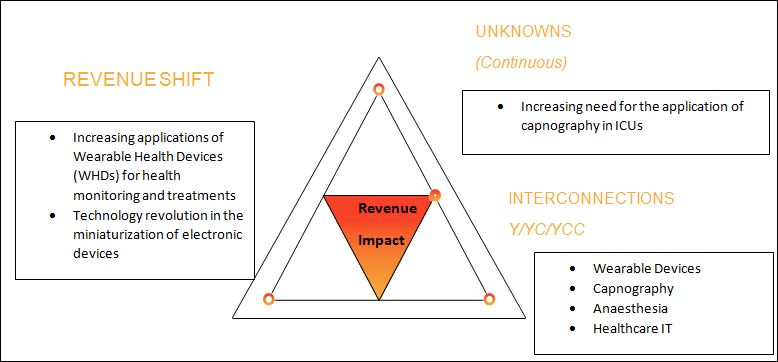Client’s Goals
Our client, an emerging medical device company, was planning to grow its revenues with the launch of an innovative CO2 monitoring device in the US. It engaged MarketsandMarkets to understand the opportunities in client’s clients’ and their clients’ side. Our team defined and solved a series of problems that helped the client to generate desired revenue impact.
Traditionally, CO2 monitoring devices are bulky and difficult to use in hospital outpatient settings such as emergency departments, ambulatory surgical centers, and clinics. The client’s innovative CO2 device is compact and user-friendly and can be easily used in outpatient surgical settings. We helped the client to understand the potential surgery types that can be target markets for its new device. For this purpose, following key questions were answered:
- Number of surgical procedures requiring procedural sedation outside hospital facilities (such as ambulatory surgery centers, emergency centers, and physician’s offices) in the US
- Number of surgical procedures based on systems in the body, such as gastrointestinal; urological; orthopedic; ophthalmic; dental; cardiovascular/thoracic; cosmetic; obstetric/gynecological; ear, nose, mouth, and pharynx; and other surgical procedures
- Insights into trends in outpatient surgeries in HOPD, ASC, and Physician’s Office
- Understanding of the forecast of the number of surgical procedures conducted outside hospital facilities with respect to segments and sub-segments of gastrointestinal surgeries; urological surgeries; orthopedic surgeries; ophthalmic surgeries; dental surgeries; cardiovascular/thoracic surgeries; cosmetic surgeries; obstetric/gynecological surgeries; ear, nose, mouth, and pharynx surgeries; and other surgeries
- Understanding of the reimbursement scenario of various surgical procedures in the US
Our Approach
Our team identified key surgeries performed in various outpatient settings such as HOPDs, ASCs, and Physician’s Offices. Among those surgeries, we estimated the number of surgeries performed through an extensive research process that involves primary and secondary research. We interviewed an array of people working in the target healthcare settings to triangulate the information acquired from secondary sources.
Our analysts expanded the understanding of the market potential across various surgical procedures such as gastrointestinal; urological; orthopedic; ophthalmic; dental; cardiovascular/thoracic; cosmetic; obstetric/gynecological; ear, nose, mouth, and pharynx; and other surgical procedures through our AI-driven market intelligence platform, KnowledgeStore. With this, our client services team devised a differentiated strategy and forged suitable alliances to help the client win in this market.
Revenue Shifts Identified
Wearable Health Devices (WHDs) are increasingly helping people to monitor their health status in a better way both at an activity/fitness level for self-health tracking and at a medical level providing more data to clinicians with a potential for earlier diagnostics and guiding treatments. The technology revolution in the miniaturization of electronic devices is enabling to design more reliable and adaptable wearables, contributing for a world-wide change in the health monitoring approach.
Interconnections
Capnography is becoming a prevalent vital sign on portable devices and is helping first responders make life-saving decisions. In a near future, it is expected that capnography become widely used outside clinical environments. To ensure this, manufactures are increasing aligning their efforts to produce reliable, cost effective and portable capnography units with quick calibration procedures. To produce successful devices, both industry and end users will have to collaborate to launch wearable/portable devices.
Unknowns Identified
For more than 25 years, capnography has had been widely used in clinical practice as integral part of anaesthesia care in operating rooms, allowing anaesthesiologists to evaluate the consciousness level of the patient during the sedation process. However, when patients are moved to the Intensive Care Unit (ICU), they are not continuously monitored with capnography. A recent study shows a high correlation of morbidity and mortality with the underuse of capnography in ICUs. Several reasons have been enumerated to explain why capnography should be considered a routine monitor, highlighting that this method can be used as a guide to metabolic rate, or as an essential adjunct to monitor the integrity of airway, cardiac output and ventilation.
Revenue Impact (RI)
Our work resulted in the client tapping into a market featuring 130 million surgical procedures, with an initial target of 70 million procedures in the US.


